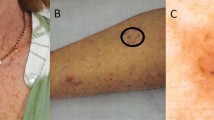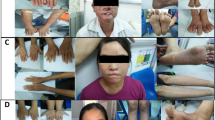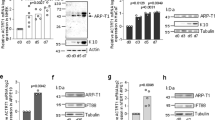Abstract
In most cases, xeroderma pigmentosum group D (XP-D) and trichothiodystrophy (TTD) patients carry mutations in the carboxy-terminal domain of the evolutionarily conserved helicase XPD, which is one of the subunits of the transcription/repair factor TFIIH (Refs 1,2). In this study, we demonstrate that XPD interacts specifically with p44, another subunit of TFIIH, and that this interaction results in the stimulation of 5´→3´ helicase activity. Mutations in the XPD C-terminal domain, as found in most patients, prevent the interaction with p44, thus explaining the decrease in XPD helicase activity and the nucleotide excision repair (NER) defect.
This is a preview of subscription content, access via your institution
Access options
Subscribe to this journal
Receive 12 print issues and online access
$209.00 per year
only $17.42 per issue
Buy this article
- Purchase on Springer Link
- Instant access to full article PDF
Prices may be subject to local taxes which are calculated during checkout




Similar content being viewed by others
References
Taylor, E. et al. Xeroderma pigmentosum and trichothiodystrophy are associated with different mutations in the XPD (ERCC2) repair/transcription gene. Proc. Natl Acad. Sci. USA 94, 8658– 8663 (1997).
Bootsma, D. & Hoeijmakers, J.H.J. DNA repair. Engagement with transcription. Nature 363, 114– 115 (1993).
Roy, R. et al. The MO15 cell cycle kinase is ssociated with the TFIIH transcription-DNA repair factor. Cell 79, 1093– 1101 (1994).
Serizawa, H. et al. Association of Cdk-activating kinase subunits with transcription factor TFIIH. Nature 374, 280– 282 (1995).
Shiekhattar, R. et al. Cdk-activating kinase complex is a component of human transcription factor TFIIH. Nature 374, 283– 287 (1995).
Schaeffer, L. et al. DNA repair helicase: a component of BTF2 (TFIIH) basic transcription factor. Science 260, 58– 63 (1993).
Schaeffer, L. et al. The ERCC2/DNA repair protein is associated with the class II BTF2/TFIIH transcription factor. EMBO J. 13, 2388–2392 (1994).
Guzder, S.N. et al. DNA repair gene RAD3 of S. cerevisiae is essential for transcription by RNA polymerase II. Nature 367, 91–94 (1994).
Guzder, S.N., Sung, P., Bailly, V., Prakash, L. & Prakash, S. RAD25 is a DNA helicase required for DNA repair and RNA polymerase II transcription. Nature 369, 578–581 (1994).
Gerard, M. et al. Purification and interaction properties of the human RNA poylmerase B(II) general transcription factor BTF2. J. Biol. Chem 266, 20940–20945 (1991).
Winkler, G.S. et al. Affinity purification of human DNA repair/transcription factor TFIIH using epitope-tagged xeroderma pigmentosum B protein. J. Biol. Chem. 273, 1092–1098 (1998).
Sung, P., Prakash, L., Matson, S.W. & Prakash, S. RAD3 protein of Saccharomyces cerevisiae is a DNA helicase. Proc. Natl Acad. Sci. USA 84, 8951– 8955 (1987).
Sung, P. et al. Human xeroderma pigmentosum group D gene encodes a DNA helicase. Nature 365, 852–855 (1993).
Ma, L., Siemssen, E.D., Noteborn, M.H.M. & van der Eb, A.J. The xeroderma pigmentosum group B protein ERCC3 produced in the baculovirus system exhibit DNA helicase activity. Nucleic Acids Res. 22, 4095–4102 (1994).
Reardon, J.T. et al. Isolation and characterization of two human transcription factor IIH (TFIIH)-related complexes: ERCC2/CAK and TFIIH. Proc. Natl Acad. Sci. USA 93, 6482–6487 (1996).
Drapkin, R., Le Roy, G., Cho, H., Akoulitchev, S. & Reinberg, D. Human cyclin-dependent kinase-activating kinase exists in three distinct complexes. Proc. Natl Acad. Sci. USA 93, 6488–6493 (1996).
Rossignol, M., Kolb-Cheynel, I. & Egly, J.M. Substrate specificity of the cdk-activating kinase (CAK) is altered upon assocation with TFIIH. EMBO J. 16, 1628–1637 (1997).
Sung, P., Higgins, D., Prakash, L. & Prakash, S. Mutation of lysine-48 to arginine in the yeast RAD3 protein abolishes its ATPase and DNA helicase activities but not the ability to bind ATP. EMBO J. 7, 3263–3269 (1988).
Iyer, N., Reagan, M.S., Wu, K.J., Canagarajah, B. & Friedberg, E.C. Interactions involving the human RNA polymerase II transcription factor/nucleotide excision repair complex TFIIH, the nucleotide excision repair protein XPG, and Cockayne syndrome group B (CSB) protein. Biochemistry 35, 2157– 2167 (1996).
Wood, R.D. Nucleotide excision repair in mammalian cells. J. Biol. Chem. 272, 23465–23468 (1997).
Lehmann, A.R. Nucleotide excision repair and the link with transcription. Trends Biochem. Sci. 20, 402–405 (1995).
Evans, E., Moggs, J.G., Hwang, J.R., Egly, J.-M. & Wood, R.D. Mechanism of open complex and dual incision formation by human nucleotide excision repair factors. EMBO J. 16, 6559–6573 (1997).
Johnson, R.T., Squires, S., Ellion, G.C., Koch, G.L.E. & Rainbow, A.J. Xeroderma pigmentosum D-HeLa hybrids with low and high ultraviolet sensitivity associated with normal and diminished DNA repair ability, respectively. J. Cell Sci. 76, 115–133 (1985).
Bürglen, L. et al. The gene encoding p44, a subunit of the transcription factor TFIIH, is involved in large scale deletions associated with ann disease. Am. J. Hum. Genet. 60, 72–79 (1997).
Yoon, H., Miller, S.P., Pabich, E.K. & Donahue, T.F. SSL1, a suppressor of a HIS4 5´-UTR stem-loop mutation, is essential for transclation initiation and affects UV resistance in yeast. Genes Dev. 6, 2463–2477 (1992).
O'Reilly, D.R., Miller, L.K. & Luckow, V.A. Baculovirus Expression Vectors. A Laboratory Manual (W.H. Freeman, New York, 1992).
Roy, R. et al. The DNA-dependent ATPase activity associated with the class II transcription factor BTF2/TFIIH. J. Biol. Chem. 269 , 9826–9832 (1994).
Acknowledgements
We wish to express our gratitude to J.H.J. Hoeijmakers, D. Moras, A. Poterszman, A. Sarasin and J.-C. Thierry for fruitful discussions, B. Bell and F.J. Dilworth for critical reading of the manuscript, J.R. Hwang for p44 mutant constructs, I. Kolb for production of recombinant in baculovirus expression system and A. Fery for her excellent technical expertise. This work was supported by grants from the Ministère de la Recherche et de l'Enseignement Supérieur (F.C. and S.F.), by the Association pour la Recherche sur le Cancer (J.C.M.), by the Human Frontier Grant, by The Hopitaux Universitaires de Strasbourg and the Telethon Grant E.550.
Author information
Authors and Affiliations
Corresponding author
Rights and permissions
About this article
Cite this article
Coin, F., Marinoni, JC., Rodolfo, C. et al. Mutations in the XPD helicase gene result in XP and TTD phenotypes, preventing interaction between XPD and the p44 subunit of TFIIH. Nat Genet 20, 184–188 (1998). https://doi.org/10.1038/2491
Received:
Accepted:
Issue Date:
DOI: https://doi.org/10.1038/2491
This article is cited by
-
The link of ERCC2 rs13181 and ERCC4 rs2276466 polymorphisms with breast cancer in the Bangladeshi population
Molecular Biology Reports (2022)
-
COL4A1, negatively regulated by XPD and miR-29a-3p, promotes cell proliferation, migration, invasion and epithelial–mesenchymal transition in liver cancer cells
Clinical and Translational Oncology (2021)
-
Mechanism and regulation of DNA damage recognition in nucleotide excision repair
Genes and Environment (2019)
-
XPD suppresses cell proliferation and migration via miR-29a-3p-Mdm2/PDGF-B axis in HCC
Cell & Bioscience (2019)
-
High-level Sp1 is Associated with Proliferation, Invasion, and Poor Prognosis in Astrocytoma
Pathology & Oncology Research (2019)



